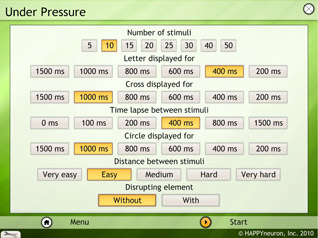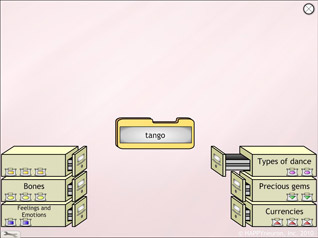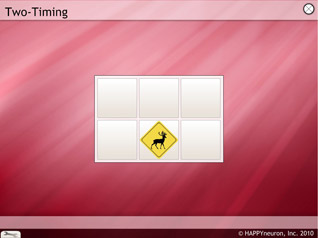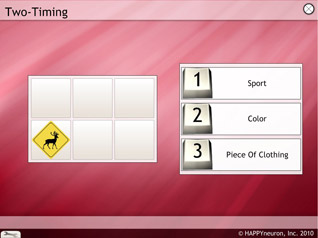Rehabilitation Program: Processing Speed
Click to try FREE for 15-Days.
This module includes activities which require answering quickly. In addition, it trains the subject's sustained attention as he has to maintain performance and vigilance over a long period of time.


Under Pressure
The task
In this exercise, three types of stimuli (a red circle, a black cross, and a letter) will appear one after the other at different spots, anywhere on the screen. The aim is to determine quickly whether the red circle appears above or below the black cross.
What it trains
This task trains the subject's sustained attention as he has to maintain performance and vigilance over a long period of time. He has to quickly detect the stimuli and scan the whole screen. It therefore also trains his visual and spatial skills. Visual-spatial skills are a set of mental processes that allow us to perceive, interpret and act on visual stimuli in our environment. Often, people aren't even aware that they are using their visual-spatial skills. As a result, people tend to take these skills for granted. The patient has to focus on the task and not let other stimuli distract him. That means he must control his actions constantly to be effective.
Parameters
The parameters that can be selected are the number of stimuli (5, 10, 15, 20, 25, 30, 40, or 50), the time of letter display on the screen (1500, 800, 600, 400, or 200 milliseconds), the time of cross display on the screen (1500, 800, 600, 400, or 200 milliseconds), the time of circle display on the screen (1500, 800, 600, 400, or 200 milliseconds), the time lapse between stimuli (0, 100, 200, 400, 800, or 1000 milliseconds), the distance between stimuli (very easy, easy, medium, hard, or very hard), and the disrupting element (without or with).
Number of Unique Configurations
Over 103,000 unique game configurations and significant data set depth.




Secret Files
The task
This task requires the patient to catch words before they fall to the ground and file them in the correct secret drawer. Each drawer is devoted to a category. When he can't see the file categories in advance, he needs to discover them by himself (trial and error) and deduce which word is associated with which file.
What it trains
This exercise primarily targets concentration and executive functioning like deductive reasoning to successfully solve a problem. In this task, the user will need to engage processes such as organizing word categories, manage his time, and focus your attention to remember the right file categories, consider errors and their consequences, control his answers, and plan ahead.
Parameters
The parameters that can be selected are the number of files (2, 3, 4, 5, or 6), the type of file (visible or hidden categories), and the speed of word (none, very slow, slow, normal, fast, or very fast).
Number of Unique Configurations
150 unique game configurations and significant data set depth.





Two-Timing
The task
In this game, you have to carry out a simple visual task, then a simple auditory task, and finally, both tasks simultaneously.
What it trains
This exercise trains you how to share your attention between two different sources of information.
Parameters
The parameters that can be selected are the number of series (for both simple and double tasks, from 4 to 30), the signs display time (from 200ms to 'unlimited'), the size of the grid (from 2 to 16 cells) and the number of sound categories (from 2 to 5).
Number of Unique Configurations
Over 13,600 unique game configurations and significant data set depth.


Click to try FREE for 15-Days.
